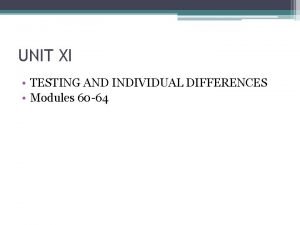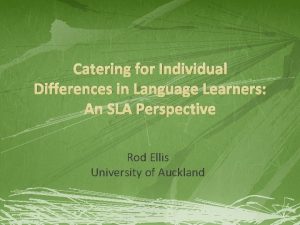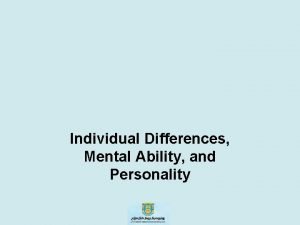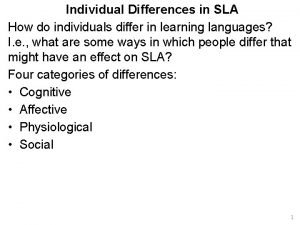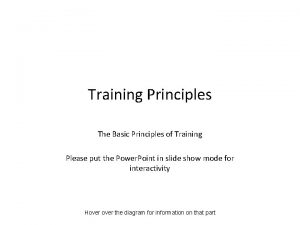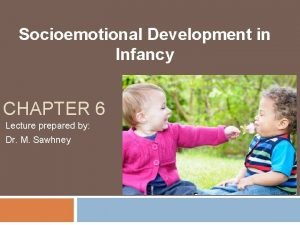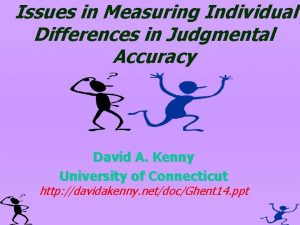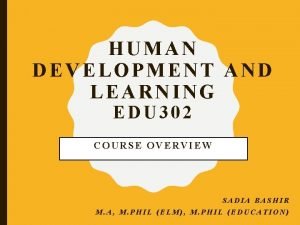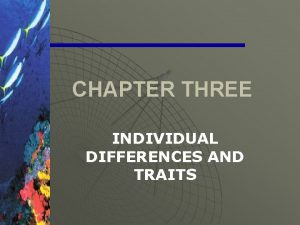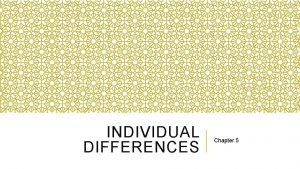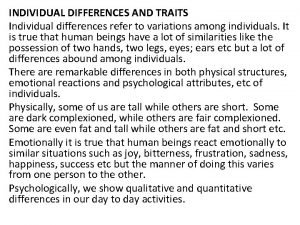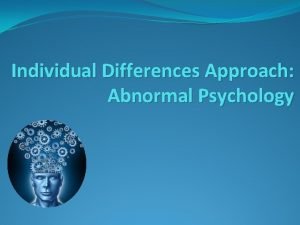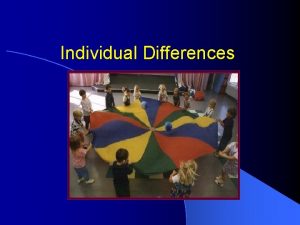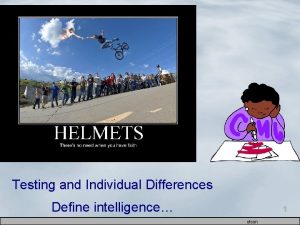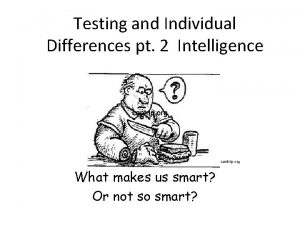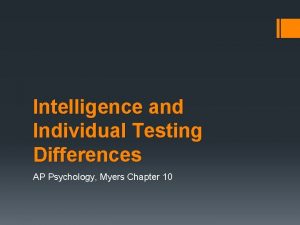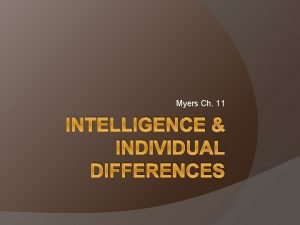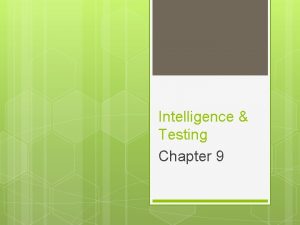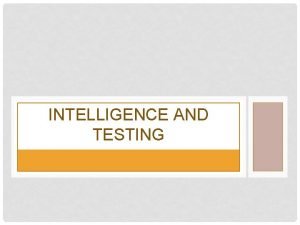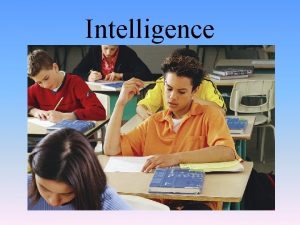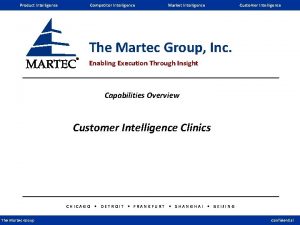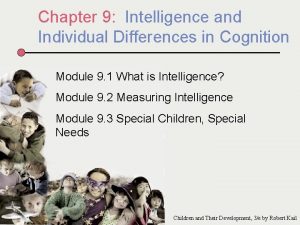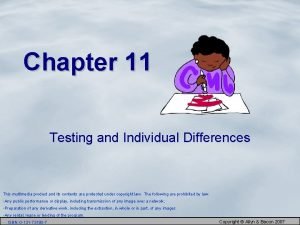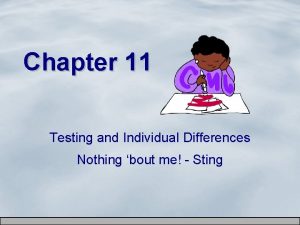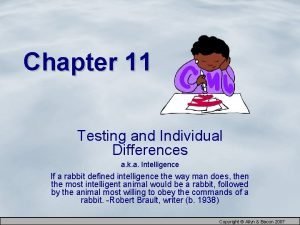Chapter 11 Testing and Individual Differences Intelligence AP
































- Slides: 32

Chapter 11: Testing and Individual Differences (Intelligence) AP Psychology Mr. Bogoff

Measuring Individual Differences Psychology relies heavily on testing individuals, it is part of the foundation for psychological analysis. To be effective, however, strict guidelines must be followed. Validity: Does the test actually measure what we say it does/what we want it to? Ex. Reading on a math test Face validity: Does the test look like it tests what it is supposed to test? Content validity: Each part of the test is representative of the larger body of knowledge.

Measuring Individual Differences Criterion Validity: The behavior (such as college grades) that a test (such as the SAT) is designed to predict Predictive Validity: The success with which a test predicts the behavior it is designed to predict.

Assessing Intelligence Football 10 linemen’s 9 success Greater correlation over broad range of body weights As the range of data under consideration narrows, its predictive power diminishes 8 7 6 5 Little correlation within restricted range 4 3 2 1 0 180 250 290 Body weight in pounds

Measuring Individual Differences The second part of a credible test is reliability. Reliability: A test yields the same results over time Test-Retest or Split-Half Reliability Reliable, but not valid Not reliable, not valid Reliable and valid

Creating Validity and Reliability The most efficient way to create validity and reliability is to use a standardized test. In the most basic sense, a standardized test means: The administration and scoring is the same for each test The results of the test can be used to draw a conclusion about the test takers in regard to the objectives of the test. Ex. AP test, S. A. T.

Judging Normal A “normal curve” is applied to test to determine establish “norms. ” When a statistically significant sample of the population has been tested, strong conclusions can be drawn. A normal range for IQ scores is 70130. Scores below 70 indicate intellectual disability while scores above 130 are considered gifted.

Normal Distribution of IQ Scores

Intellectual Disability = (formerly referred to as mental retardation) a condition of limited mental ability, indicated by an intelligence score of 70 or below and difficulty in adapting to the demands of life; varies from mild to profound.

Extremes of Intelligence Classifications of Intellectual Disability Level Approxima te Intelligenc e Scores Adaptation to Demands of Life Mild 50 -70 May learn academic skills up to sixthgrade level. Adults may with assistance, achieve self-supporting social and vocational skills Moderat e 35 -50 May progress to second-grade level academically. Adults may contribute to their own support by laboring in sheltered workshops Severe 20 -35 May learn to talk and to perform simple tasks under close supervision but are

Extremes of Intelligence The High Extreme Terman’s study of gifted Self-fulfilling prophecy Appropriate developmental placement Tracking students

Twin and Adoption Studies Identical twin studies Polygenetic Adoptive children studies

Heritability

Types of Tests There are two main types of tests: 1. Objective Tests: Tests that have one set answer, that can be scored easily by machine Ex. Multiple choice 2. Subjective Tests: Tests in which individuals are given ambiguous figures or an open ended question which requires some interpretation and analysis. Ex. FRQs Inter-rater reliability

Sample Subjective Test The Rorschach Inkblot Test is one of the most widely known, and inaccurate subjective tests. The following slides are real inkblots from the test that was, at one time, a widely used test. Today, it has lost much, if not all of its credibility in determining intelligence or mental illness.







Intelligence Testing A term that is used frequently, but often misunderstood is “intelligence. ” What exactly is intelligence? Many people disagree about what exactly intelligence is, but most do agree that it is: Relative: defined in relation to the same abilities in a comparison group (usually age) Hypothetically constructed: it is unobservable, but instead inferred from behavior

Testing IQ IQ (intelligence quotient) became a popular way to classify people in the early 1900 s when two French psychologists (Alfred Binet and Theodore Simon) developed a test to identify those students who were gifted, and those who needed extra help.

Binet-Simon. Test The test had four important distinctions: Scores were interpreted at their current performance Used to identify students in need of help, not label them or categorize them Emphasized that training and opportunity could affect intelligence Was empirically constructed Scoring the test was done by calculating the mental age (MA) and the chronological age (CA). MA= The average at which normal individuals achieve a particular score CA= The number of years since an individuals birth

Coming to America The idea of IQ testing became popular in America for three reasons: A huge increase in immigration New laws requiring universal education Military assessing new recruits for WWI It created an inexpensive and objective way to separate those could benefit from education or military leadership training and those who needed assistance.

Downside of IQ Testing Despite its utility, IQ testing had a big downside. Tests ended up reinforcing prevailing prejudices about race and gender. Ignored was the fact that environmental disadvantages limit the full development of people’s intellectual abilities. Also in education legislature

Stanford-Binet Intelligence Scale When the Binet test was adopted by a Stanford professor, he changed the equation to make intelligence scores into non-decimal numbers. This now became known as the Intelligence Quotient (IQ). =IQ

Components of Intelligence Savant Syndrome: Individuals with remarkable, but rare talent, even though they are mentally deficient in other areas. Ex. Dustin Hoffman in Rain Man

Theories of Intelligence Spearman’s g Factor: Charles Spearman thought intelligence was a general factor behind all of our mental ability. Catell’s Fluid and Crystallized Intelligence The g factor

Theories of Intelligence Howard Gardner believed that IQ scores measured only a limited range of human mental abilities. He argued we have eight separate mental abilities he calls the multiple intelligences. Linguistic intelligence ("word smart"): Logical-mathematical intelligence ("number/reasoning smart") Spatial intelligence ("picture smart") Bodily-Kinesthetic intelligence ("body smart") Musical intelligence ("music smart") Interpersonal intelligence ("people smart") Intrapersonal intelligence ("self smart") Naturalist

Is Intelligence One General Ability or Several Specific Abilities? Theories of Multiple Intelligences

 Unit xi testing and individual differences
Unit xi testing and individual differences Managing individual differences and behavior
Managing individual differences and behavior Proactive personality
Proactive personality Individual differences factors
Individual differences factors Catering to individual differences
Catering to individual differences Individual differences in workplace
Individual differences in workplace Apa makna perbedaan individu dalam dunia kerja
Apa makna perbedaan individu dalam dunia kerja Individual differences factors
Individual differences factors Individual differences in sla
Individual differences in sla Basic principles of training
Basic principles of training Principles of training individual differences
Principles of training individual differences Involves individual differences in behavioral styles
Involves individual differences in behavioral styles Conclusion of individual differences
Conclusion of individual differences Growth and development
Growth and development Positive testing and negative testing
Positive testing and negative testing Cs3250
Cs3250 A survey of the history of intelligence testing reinforces
A survey of the history of intelligence testing reinforces Audience intelligence testing
Audience intelligence testing Intelligence testing
Intelligence testing Intelligence testing
Intelligence testing Domain test means
Domain test means Motivational overview in software testing
Motivational overview in software testing Du path testing
Du path testing Globalization testing
Globalization testing Functional testing vs unit testing
Functional testing vs unit testing Decision table testing in software testing
Decision table testing in software testing Control structure testing in software engineering
Control structure testing in software engineering Decision table testing in software testing
Decision table testing in software testing What is decision table testing
What is decision table testing Pengertian black box testing
Pengertian black box testing Behavior testing adalah
Behavior testing adalah Decision table for triangle problem
Decision table for triangle problem Rigorous testing in software testing
Rigorous testing in software testing
